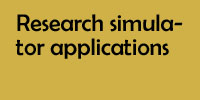Research driving simulators are used by research institutes, universities and car manufacturers. The typical advantages of using research simulators over real cars in the real world are:
- Control over the environment and experimental conditions. If you want to do research in a real vehicle on public roads, two drives will never be the same. Weather, lighting, and traffic conditions always vary which will introduce a lot of uncontrolled measurement error in any experimental design. Also, in a driving simulator experimental conditions can be specified exactly, while this often is impossible in the real world.
- Ease of measurement and data analysis. Ofcourse vehicles can be equipped with data measurement equipment (instrumented vehicle), but the ease of measurement in a simulator is unprecedented. Just specify the data you want to sample and the data sampling frequency and you are ready to go. Also, a lot if data if often difficult to measure in the real world, while in a simulator all data are often internally available (for example, time to intersection of vehicles approaching the intersection). This not only reduces costs tremendously, it also enabled experiments that are impossible to perform otherwise. Since the use of research simulators in traffic psychology, research into driving behaviour and the accumulation of knowledge has strongly increased,
- Ethical considerations. Often it is undesirable to do research on the road because of ethical condiderations. Studies on the effects of alcohol and various drugs (sleeping pills, amphetamine etc) and of sleeping deprivation and fatigue are often better done in a simulator because of safety considerations.
Although the market for driver training is larger than for driver behaviour research, research simulators are used for a number of different purposes:
- Human factors studies. An important use of research simulators is in human factor studies. This involves studies on the relation between man and machine. Studies on workload, the use of secondary tasks, the effects of presentation mode of information on driving performance, the effects of equipment (for example smart phones) on distraction etc, all are mostly done in simulators.
- Effects of road infrastructure. When a road is designed the effects of road layout on driving behaviour can be studied in a simulator. Also, the effects of lighting conditions (streetlights) and road signs can be studies easily.
- Driver behaviour modeling. At universities, the car driving task is often considered as a convenient task to study different factors of human behaviour. This concerns questions such as: What information do people use in their car following behaviour and how is choice of headway related to risk taking ?
- Driver performance and impairment. The effects of alcohol and drugs on driver performance is studied in research simulators. Also the effects of prolonged driving and other factors that result in driver impairment are often studied in simulators.
- Vehicle design. In the car industry, research simulators are used to study the effects of design decisions of driver behaviour. This usually requires very advanced engine and vehicle models, which makes these simulator usually expensive.

